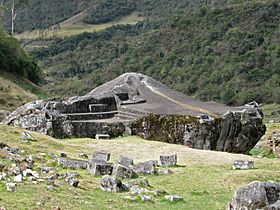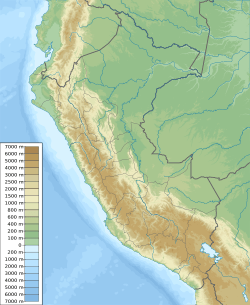Ñusta Hispana facts for kids

Yurac Rumi ("white stone") at Ñusta Hispana
|
|
| Alternative name | Ñusta Ispanan, Chuquipalta |
|---|---|
| Location | Vilcabamba, Cusco Region |
| Coordinates | 13°6′42″S 72°55′27″W / 13.11167°S 72.92417°W |
| Type | Settlement |
| History | |
| Cultures | Inca |
Ñusta Hispana (also called Ñusta Ispanan or Chuquipalta) is an important ancient site in Peru. It is located in the Vilcabamba area, within the Cusco Region. This site was once part of the powerful Inca civilization.
What is Ñusta Hispana?
Ñusta Hispana is an archaeological site. This means it is a place where people find old buildings and objects. These findings help us learn about how people lived long ago. The site is famous for a large, carved rock.
The White Rock: Yurac Rumi
A very special part of Ñusta Hispana is a carved rock. It is known as Yurac Rumi. This name means "White Rock" in the Quechua language. This rock has unique carvings. It shows how skilled the Inca people were.
Discovery and History
The site of Ñusta Hispana was found by Hiram Bingham III. He was an American explorer. Bingham discovered the site on August 9, 1911. He was looking for lost Inca cities.
During his visit, Bingham noted some interesting history. He learned that in the past, during the time of an Inca leader named Titu Cusi, the site saw some changes. Monks had caused some damage to parts of the site, including the famous White Rock. This happened when Titu Cusi was not there.
Gallery
See also
 In Spanish: Ñusta Hispana para niños
In Spanish: Ñusta Hispana para niños





